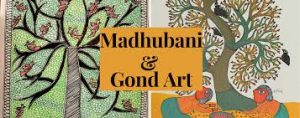Madhubani and Gond Art:

Artists of Madhubani and Gond art met President Droupadi Murmu under the Artists-in-Residence Programme – Kala Utsav at Rashtrapati Bhavan.
Madhubani Art (Mithila Art):
- Originates from the Mithila region of Bihar; also referred to as Mithila painting.
- A folk-art form traditionally created by women on walls and floors of huts during auspicious occasions.
- Now practiced on cloth, canvas, and handmade paper.
- Uses plant-based pigments, cow dung-treated paper, and bamboo pens.
- Black lines made with cow dung and charcoal; filled with vibrant natural colors.
- Themes: Depictions of Hindu deities like Radha-Krishna, Shiva, Saraswati, etc.
- Social: Scenes from village life, weddings, and festivals.
- Nature: Birds, animals, trees (Tulsi, Banyan), sun, and moon.
- Cultural Identity: Symbol of female creativity and rural tradition passed down through generations.
Gond Art:
- Practiced by Pardhan Gond tribes of Madhya Pradesh and adjoining Central Indian states.
- Tribal art form with roots in oral storytelling and ritualistic practices.
- Initially drawn on walls of homes to depict folk tales and nature.
- Mythical Narratives: Depicts divine stories, village folklore, and animist beliefs.
- Pattern Work: Fills motifs with fine dots and lines to create visual rhythm.
- Nature Connection: Harmonious coexistence of humans, flora, and fauna.
- Colour Use: Bright, bold colour schemes with creative compositions.
- Global Reach: Popularized internationally through works like “The Night Life of Trees” by Tara Books.




